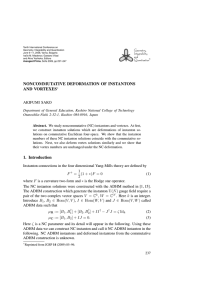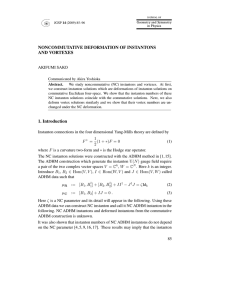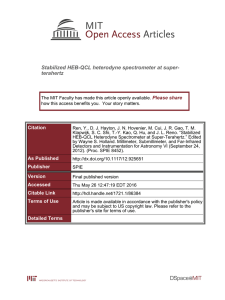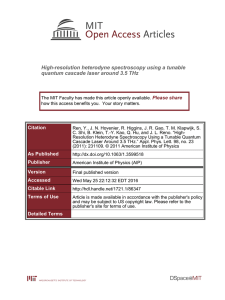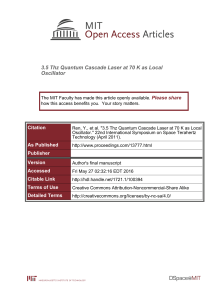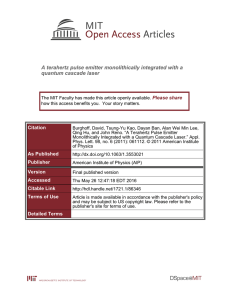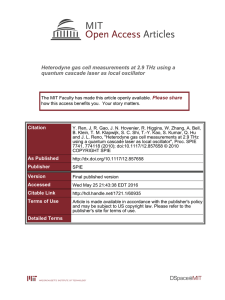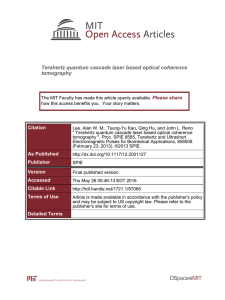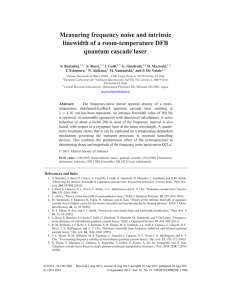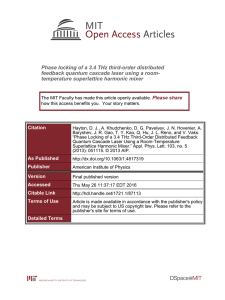Lecture XIII: Double Well Potential: Tunneling and Instantons
advertisement
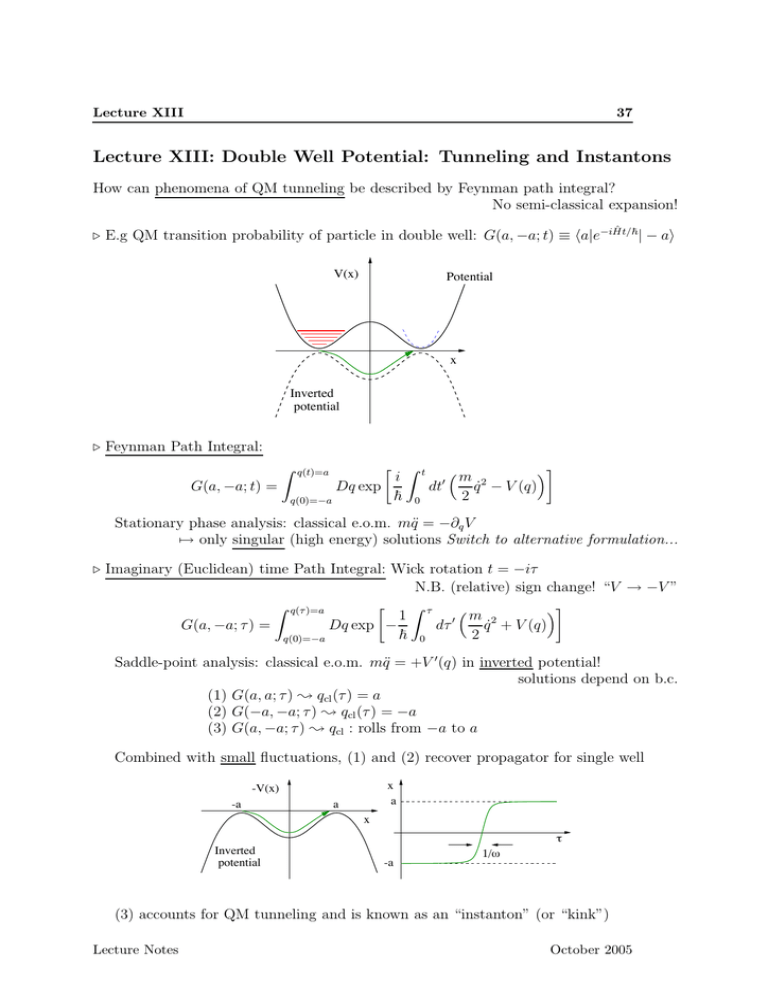
Lecture XIII 37 Lecture XIII: Double Well Potential: Tunneling and Instantons How can phenomena of QM tunneling be described by Feynman path integral? No semi-classical expansion! ! E.g QM transition probability of particle in double well: G(a, −a; t) ≡ #a|e−iĤt/!| − a$ V(x) Potential x Inverted potential ! Feynman Path Integral: " ! t # $% i " m 2 q̇ − V (q) G(a, −a; t) = Dq exp dt ! 0 2 q(0)=−a ! q(t)=a Stationary phase analysis: classical e.o.m. mq̈ = −∂q V %→ only singular (high energy) solutions Switch to alternative formulation... ! Imaginary (Euclidean) time Path Integral: Wick rotation t = −iτ N.B. (relative) sign change! “V → −V ” " ! ! q(τ )=a $% 1 τ " #m 2 q̇ + V (q) Dq exp − dτ G(a, −a; τ ) = ! 0 2 q(0)=−a Saddle-point analysis: classical e.o.m. mq̈ = +V " (q) in inverted potential! solutions depend on b.c. (1) G(a, a; τ ) ! qcl (τ ) = a (2) G(−a, −a; τ ) ! qcl (τ ) = −a (3) G(a, −a; τ ) ! qcl : rolls from −a to a Combined with small fluctuations, (1) and (2) recover propagator for single well x a -V(x) -a a x o Inverted potential -a 1/t (3) accounts for QM tunneling and is known as an “instanton” (or “kink”) Lecture Notes October 2005 Lecture XIII 38 ! Instanton: classically forbidden trajectory connecting two degenerate minima — i.e. topological, and therefore particle-like τ →∞ For τ large, q˙cl ' 0 (evident), i.e. “first integral” mq˙cl 2 /2 − V (qcl ) = $ → 0 precise value of $ fixed by b.c.& (i.e. τ ) Saddle-point action (cf. WKB dqp(q)) ! τ ! ! ! $ # τ a a " m 2 " 2 dτ dτ mq̇cl = dqcl mq̇cl = dqcl (2mV (qcl ))1/2 q̇cl + V (qcl ) ' Sinst. = 2 0 0 −a −a τ →∞ Structure of instanton: For q ' a, V (q) = 12 mω 2 (q − a)2 + · · ·, i.e. q̇cl ' ω(qcl − a) τ →∞ qcl (τ ) = a − e−τ ω , i.e. temporal extension set by ω −1 ( τ Imples existence of approximate saddle-point solutions involving many instantons (and anti-instantons): instanton gas x a o4 o5 o3 o2 o1 o -a ! Accounting for fluctuations around n-instanton configuration ' G(a, ±a; τ ) ' Kn ! τ dτ1 0 n even / odd ! τ1 0 dτ2 · · · ! τn−1 0 An,cl. An,qu. ( )* + dτn An (τ1 , . . . , τn ), constant K set by normalisation An,cl. = e−nSinst. /! — ‘classical’ contribution An,qu. — quantum fluctuations (imported from single well): Gs.w. (0, 0; t) ∼ An,qu. ∼ n , i - G(a, ±a; τ ) ' = ' 1 sin(−iω(τi+1 − τi )) ' Using ex = Lecture Notes n=0 i e−ω(τi+1 −τi )/2 ∼ e−ωτ /2 n −nSinst. /! −ωτ /2 K e e e−ωτ /2 xn /n!, ( ! 0 n even / odd n even / odd 0∞ ∼ n , √ 1 sin ωt /n 1 . τ Ke−Sinst. /! n! . τ dτ1 ! τ n /n! τ1 0 )* dτ2 · · · ! τn−1 + dτn 0 N.B. non-perturbative in !! / /! G(a, a; τ ) ' Ce−ωτ /2 cosh τ Ke−Sinst. / . G(a, −a; τ ) ' Ce−ωτ /2 sinh τ Ke−Sinst. /! October 2005 Lecture XIII 39 Consistency check: main contribution from 0 nX n /n! = X = τ Ke−Sinst. /! n̄ = #n$ ≡ 0n n X /n! n no. per unit time, n̄/τ exponentially small, and indep. of τ , i.e. dilute gas ^ A S Exact States Oscillator States ht A S x ! Physical interpretation: For infinite barrier — two independent oscillators, coupling splits degeneracy — symmetric/antisymmetric G(a, ±a; τ ) ' #a|S$e−#S τ /!#S| ± a$ + #a|A$e−#Aτ /!#A| ± a$ |#a|S$|2 = #a|S$#S| − a$ = C , 2 |#a|A$|2 = −#a|A$#A| − a$ = Setting: $A/S = !ω/2 ± ∆$/2 / C . −(!ω−∆#)τ /2! e G(a, ±a; τ ) ' ± e−(!ω+∆#)τ /2! = Ce−ωτ /2 2 1 C 2 cosh(∆$τ /!) . sinh(∆$τ /!) ! Remarks: (i) Legitimacy? How do (neglected) terms O(!2 ) compare to ∆$? In fact, such corrections are bigger but act equally on |S$ and |A$ i.e. ∆$ = !Ke−Sinst. /! is dominant contribution to splitting V(q) ïV(q) q q m q qm o (ii) Unstable States and Bounces: survival probability: G(0, 0; t)? No even/odd effect: " % 3 2 Γ −ωτ /2 −Sinst /! τ =it −iωt/2 exp τ Ke = Ce exp − t G(0, 0; τ ) = Ce 2 Decay rate: Γ ∼ |K|e−Sinst /! (i.e. K imaginary) N.B. factor of 2 Lecture Notes October 2005
![ )] (](http://s2.studylib.net/store/data/010418727_1-2ddbdc186ff9d2c5fc7c7eee22be7791-300x300.png)
